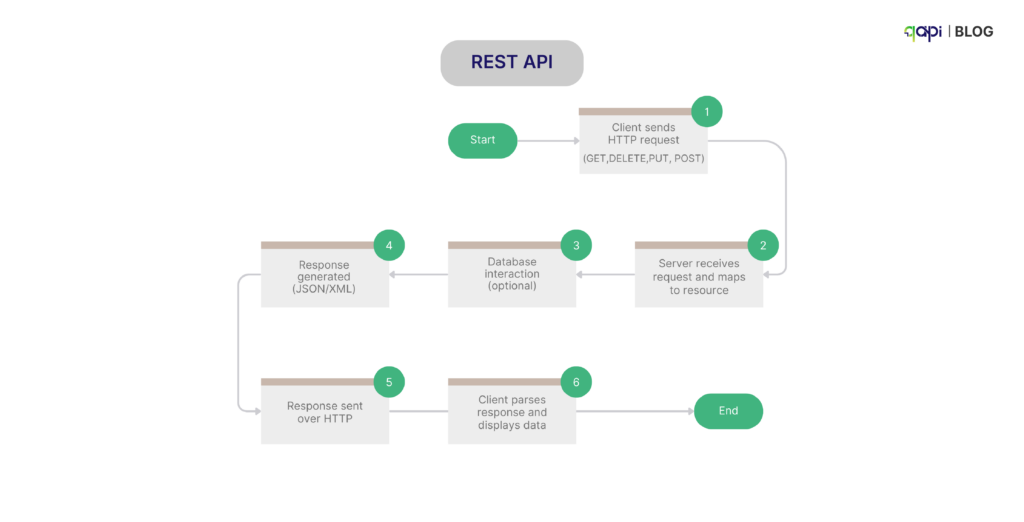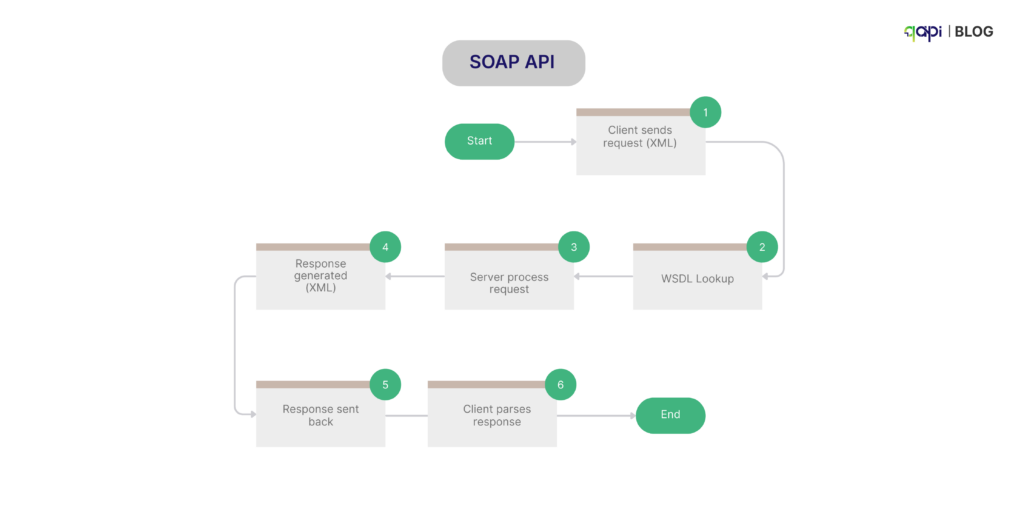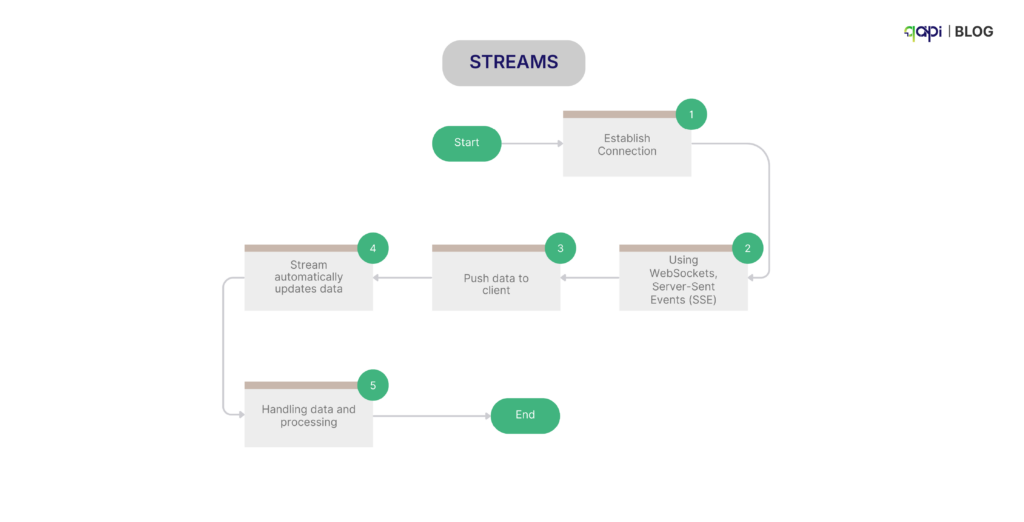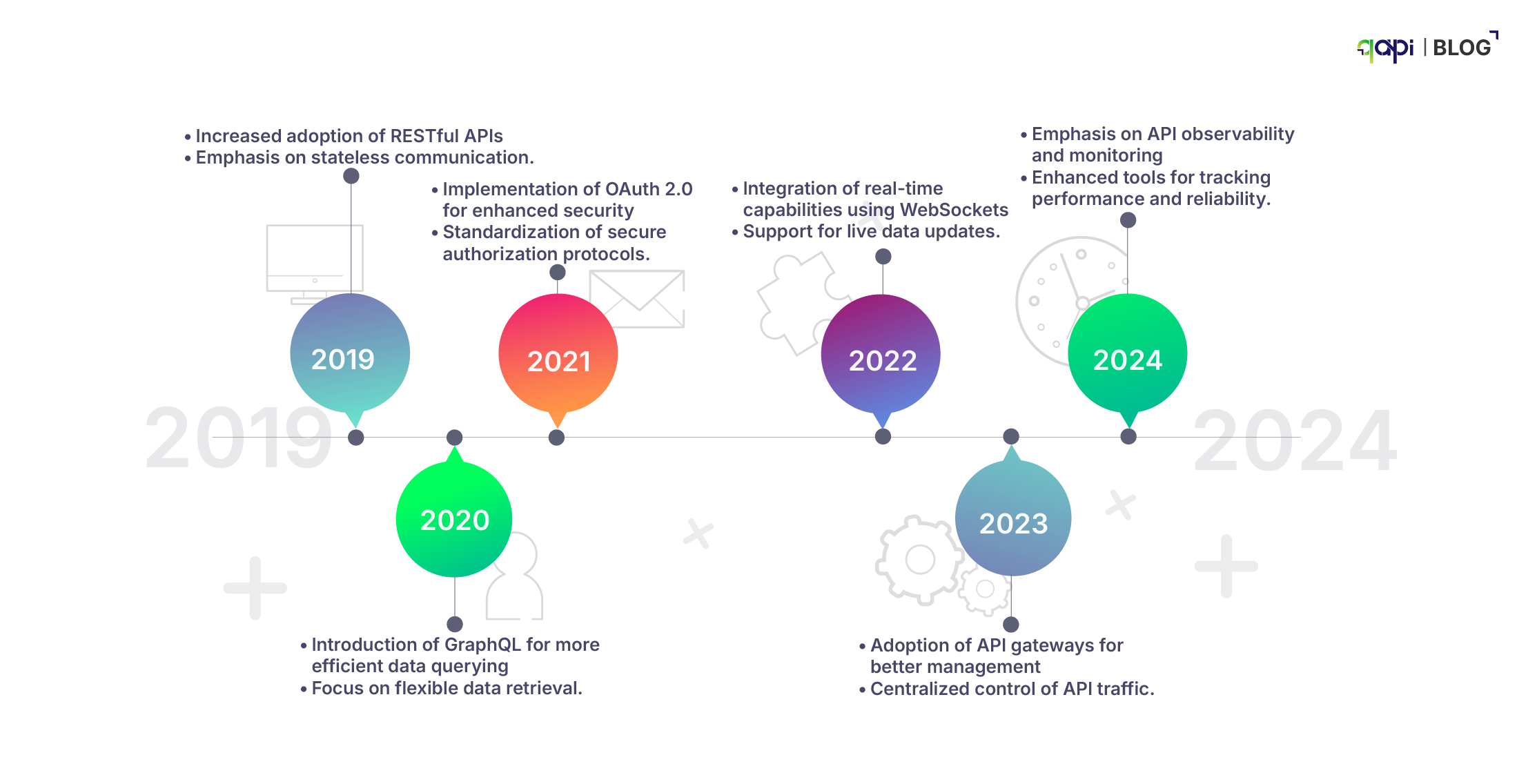Why Should You Go Codeless for API testing in 2025? Our whitepaper is live—Download now
Why Should You Go Codeless for API testing in 2025? Our whitepaper is live—Download now
Lorem ipsum dolor sit amet, consectetur adipiscing elit. Ut elit tellus, luctus nec ullamcorper mattis, pulvinar dapibus leo.
You’re spending a lot of time testing APIs and under different conditions. With every test you run, the success rate you achieve, there are some learnings along the way that make you realize lot more than you usually account for.
Consider a rapidly growing company working towards refining its digital infrastructure. Their engineering team must make an important decision, on picking the API strategy that supports expansion while maintaining performance and flexibility.
REST has been the industry-standard for long, but GraphQL is gaining traction for its precise data-fetching capabilities. SOAP, though considered legacy, remains the backbone of industries like banking and healthcare due to its reliability and security. Meanwhile, event-driven architectures, powered by Streams, are transforming real-time data processing.
The Challenge?
Each approach has trade-offs—REST is simple but can often exposure to multiple inefficiencies in data retrieval. GraphQL offers flexibility but adds complexity, SOAP on the other hand ensures strict compliance but feels rigid in modern agile environments. And Streams enable real-time interactions but requires long list of efforts to make a shift in system design. Organizations must make these choices wisely, to balance performance, security, and scalability.
API testing differs from the tasks you need to execute to validate functionality and performance, rather than just verifying outputs. It involves understanding the nuances of data transmission, error handling, and system interactions, helping you refine your approach to scalable testing and automation.
Learn about the four popular API paradigms—REST API, SOAP, GraphQL, and Streams —to you developers and testers understand their relevance, functionality, and when to use them. By the end, you’ll have a clearer picture of which API approach aligns best with your product, your users, and your long-term vision. Let’s dive in.
All these are different types of APIs each created to serve a unique proposition and use case. From building the right mobile application to integrating microservices, having the right API architecture in place makes all the difference.
At a time where code makes or breaks a product it’s important to know what they are, what they can do before you figure out how to use them.
REST API is an architectural template introduced in the 2000s built to be easy to use and implement. It uses the standard HTTP methods (GET, POST, PUT, DELETE) to interact with resources and design networked applications.
REST APIs support caching mechanisms (via HTTP headers like Cache-Control and ETag) to reduce the load on the server. And majorly use JSON or XML for data exchange.
The reason why it’s used widely is REST’s stateless nature making it a good fit for applications that need to grow and handle high traffic.
Ideal use case: Web and mobile apps, public APIs, microservices.
Example: You can search the user data from a server using a GET request to /users/1.
How does a REST API work: REST APIs uses standard HTTP methods to execute CRUD (Create, Read, Update, Delete) operations. Here each request is stateless, as it contains all necessary information for processing, and responses are in JSON or XML format.

SOAP was introduced in the late 1990s and is one of the oldest protocols used for exchanging structured information in distributed systems. The intent was to design and establish strict standards for enterprise-level communication.
SOAP has advantages in industries that need high security and reliability, such as banking, healthcare, and government entities. The rigid structure on SOAP provides consistency and compliance with standards like WS-Security.
Ideal Use Case: Enterprise applications, financial transactions, legacy systems.
Example: You can create a SOAP request to a banking service to initiate transfer funds:

How does SOAP API work: SOAP operates on an XML-based messaging format and requires a strong protocol specification. It supports ACID* transactions, built-in error handling, and enterprise-grade security features.
SOAP Uses WSDL (Web Services Description Language) for defining operations.
*FYI- ACID stands for Atomicity, Consistency, Isolation, and Durability—it’s a set of features that help maintain data integrity, especially in enterprise applications dealing with sensitive or financial data.

GraphQL was developed and launched in the market by Facebook in 2015 to address inefficiencies that were found in the REST APIs, aiming to solve issues related to over-fetching and under-fetching of data. It helped users to request exactly what they needed, while eliminating the need for unnecessary data transfer.
GraphQL grew its popularity in mobile and web applications as the need for dynamic data requirements were crucial in these segments. It’s ideally useful for complex queries and real-time updates.
You can easily use a single endpoint (/graphql) instead of multiple routes.
For example: A user can write a request to server for a user’s name and email:

How does GraphQL work: GraphQL enables clients to request precisely the data they need through a structured query language. Instead of multiple API calls, clients can send a single query specifying exactly what they need.
Streams
Streams were developed as a resource to handle continuous data flow in real-time for applications. As traditional APIs operated on request-response models, Streams are capable of enabling constant data transmission within separate systems.
Streams pushes data to clients as it becomes available. It’s put into action by using technologies like WebSockets, Server-Sent Events (SSE), Kafka, or gRPC Streams.
How does streams work?

Now you might get confused as even GraphQL has the same functionality, but the difference lies in the approach.
|
Feature
|
GraphQL | Streams |
| Underlying Mechanism | Built on WebSockets to push updates from the server when data changes. | Uses various streaming protocols like WebSockets, SSE, Kafka, or gRPC for continuous or event-driven data transmission. |
| Data Flow | Clients subscribe to specific changes (e.g., updates to a particular entity). | Data flows continuously (like a live feed) or is pushed based on events. |
| Use Case | Best for applications where clients need to get real-time updates on specific queries (e.g., chat apps, stock price updates). | Ideal for high-throughput, event-driven, or real-time streaming use cases (e.g., video streaming, IoT, analytics pipelines). |
| Scalability | Can be complex to scale due to WebSocket limitations. Requires additional infrastructure for large-scale deployments. | Designed for high-scale real-time processing (e.g., Kafka handles millions of messages per second). |
| State Management | Works well for structured, stateful real-time updates. | Works for both stateful and stateless event-driven architectures. |
When to use SOAP vs REST vs GraphQL vs Streams?
When should you use REST API:
Example: Social media platforms like Twitter use REST APIs for fetching tweets, posting updates, and managing user profiles.
When should you use SOAP:
Example: Payment gateways like PayPal heavily use SOAP APIs to secure money transactions, ensuring integrity and security.
When should you use GraphQL:
Example: GitHub uses GraphQL APIs to allow developers to fetch repository details, issues, and pull requests in a single query, improving efficiency.
When should you use Streams:
Example: Netflix leverages streaming APIs to deliver video content in real-time, ensuring seamless playback and adaptive streaming.
|
|
REST | SOAP | GraphQL | Streams |
| Design | Exposes data/resources via URIs. Focuses on CRUD operations (Create, Read, Update, Delete). | Exposes operations (functions or actions) via a strict contract. Focuses on service actions. | Exposes a flexible query system that allows clients to request exactly the data they need. | Exposes a continuous stream of events or data, often in real-time, through a persistent connection. |
| Transport Protocol | HTTP/HTTPS | HTTP/HTTPS, SMTP, JMS, etc. | HTTP/HTTPS | WebSockets, HTTP/2, MQTT, gRPC |
| Data Format | Typically, JSON or XML | XML | JSON (typically) | Varies (JSON, Avro, Protobuf, etc.) |
| Performance | Generally fast, lightweight, stateless, scalable. | Slower due to XML parsing and overhead. | Can be efficient but depends on query design (over-fetching, under-fetching). | High performance for real-time, but latency can vary based on connection. |
| Scalability | Easily scalable with caching and load balancing. | Less scalable due to heavier processing overhead. | Highly scalable with efficient query design. | Highly scalable, especially in real-time environments. |
| Security | Typically relies on HTTPS, OAuth, and API keys. | Built-in WS-Security, SSL, and additional standards. | Relies on HTTPS, OAuth, and custom access control. | Security relies on the transport layer (e.g., SSL/TLS). |
Validate Endpoint Configurations:
Ensure Correct HTTP Status Codes:
Implement Efficient Caching:
XML Schema Validation:
Verify Required Headers:
Test for Security Flaws:
Test for Efficient Query Handling:
Validate Resolver Logic and Data Integrity:
Optimize Query Efficiency:
Check Connection Stability:
Avoid Duplicate Event Handling:
Minimize Latency:
qAPI offers end-to-end API testing services to support your growing API needs. Our cloud-based application is a fully managed service that makes it easy for developers/testers/QA teams to test, monitor and secure APIs of all types and sizes.
Here are some ways you can benefit from using qAPI.
Get started with qAPI by creating a free account today.
The Untold Story of API Testing: How Tester-Centric Tools are Changing the Game
Picture this: An ambitious FinTech startup is racing to launch a groundbreaking mobile app that promises seamless digital banking. The team’s deadline is tight, and the pressure to deliver is immense. Just days before the launch, during UI validation, testers uncover a critical issue—users can’t complete transactions during peak hours. The core problem? API bottlenecks that were never tested under real-world scenarios.
We are at a phase where digital products are at the heart of business growth, APIs are the unsung heroes—powering everything from microservices and payment gateways to personalized customer experiences. Yet, many organizations approach API testing with a traditional-focused lens, leaving critical gaps that only testers can address.
Let’s take a closer look at why this is a growing challenge.
The Developer-Centric Dilemma
Most teams rely on tools like Postman, Insomnia and SwaggerHub for API development and basic validation. While these tools are powerful for developers, they often fall short when it comes to the broader, user-focused testing needed to ensure seamless experiences. Why?
For example– Imagine an API handling loan applications for a digital bank. While it might respond correctly to individual requests, what happens when 10,000 users apply simultaneously? Or if a user inputs incorrect data, will it properly reject the request or still process it? Or when one downstream API—like credit scoring—is slow? It can potentially result in a cascading effect, disrupting the entire loan application process and impacting user experience.
These scenarios are often missed in developer-centric testing.
The Stakes in BFSI
Financial institutions often handle critical operations like loan disbursements, transaction processing, and fraud detection through APIs. Any failure in these APIs can lead to not just financial loss but also regulatory penalties and reputational damage.
Although essential for all industries like BFSI, FinTech, e-Commerce, and Retail companies are especially advised to have a robust API testing in place.
In early 2024, a big API security breach occurred due to a buggy API that led to unauthorized access of close to 650,000 sensitive messages. This major outbreak not only exposed Office 365 passwords but also enabled unauthorized individuals to extract a ton of confidential information.
Another example that comes to my mind is of Equifax, a credit reporting agency, which suffered a massive data breach in 2017 due to vulnerabilities in its APIs. The breach exposed the personal data of 147 million people and resulted in a $700 million settlement, highlighting the critical need for robust API testing.
Ever Increasing Need for Tester-Centric Tools

This is where tools like qAPI come into play. Unlike traditional API development platforms, qAPI is designed with testers in mind, focusing on the bigger picture of quality assurance.
Here’s how a tester centric tool empowers testers:
Why API Testing is Critical from a Tester’s View: Seeing the Big Picture
A payment gateway API for a global bank failed to validate edge cases like duplicate transactions during high traffic periods. This oversight led to customer disputes and operational delays. Post-incident, the bank adopted a holistic API testing strategy, preventing similar issues in the future.
Testers bring a unique perspective to API testing. Unlike developers, they think beyond the API’s individual functionality, focusing on:
Our client built a payment gateway API, that passed all developer-run tests but failed during UAT when processing refunds. Testers using qAPI identified the issue—an edge case where negative amounts weren’t validated—preventing customer disputes.
Another success story is about a digital lender offering instant loans which suffered delays during peak hours due to API timeouts. By switching to a tester-centric approach with qAPI, they uncovered and fixed performance bottlenecks, improving transaction success rates by 30%.
The Future—AI-Driven API Testing
AI is transforming API testing in profound ways. Here’s how:
To give you context to how AI is transforming API testing, a digital bank’s loan processing API faced performance issues when many requests were made at the same time. AI-driven testing facilitated building and executing a performance test that flagged discrepancies in response times, enabling optimizations that improved processing speed by 25%.
There are many success stories around how AI has augmented API testing for an organization and speed up their release cycles. Another such example is of an insurer who used AI to simulate high-volume claims processing, uncovering scalability issues before a major storm. This proactive testing ensured seamless service during a critical period.
API testing isn’t just a technical task—it’s a strategic imperative. Organizations that fail to evolve risk losing customers, revenue, and trust. But those who empower testers with tools that can deliver exceptional quality, building trust and loyalty.
Traditional testing was often limited to tracking individual API calls, but API process testing validates entire workflows, ensuring that every step functions as expected. A payment API, for instance, doesn’t just process transactions; it interacts with fraud detection, banking systems, and notification services.
Without a process testing metric in place, a critical failure—like an order being placed but payment failing—can go unnoticed. Enabling testers to create complex workflows without writing code, making end-to-end validation easier and more reliable.
Impact that a good API testing framework can have
An API can always function perfectly under normal conditions but what happens under high load, is always a grey area. API process-performance testing helps teams to beyond verifying correctness; it ensures that APIs perform reliably under different traffic conditions. For instance, imagine a travel booking API that has over thousands of simultaneous flight searches during a holiday sale. If response times degrade or errors spike, users abandon their bookings, directly impacting revenue.
As we reflect on the evolving landscape of API testing, it becomes clear that this practice is no longer a mere step in the software development lifecycle—it’s a foundational pillar of digital success. APIs are the invisible threads weaving together our interconnected digital world.
Whether it’s a financial institution enabling seamless cross-border payments, an e-commerce platform ensuring glitch-free checkouts during peak sales, or a healthcare provider safeguarding sensitive patient data, robust API testing underpins every meaningful interaction in our modern lives.
The stakes are high, and the need for a paradigm shift is urgent. Developer-centric testing tools, while valuable, are not enough to address the complex workflows and real-world scenarios that define today’s digital ecosystems. This is where tester-centric platforms like qAPI shine, empowering QA teams with the tools, automation, and AI-driven insights they need to test smarter, faster, and more comprehensively.
The future of API testing is bright, driven by innovation and a commitment to quality. It is a future where AI not only predicts and prevents failures but also accelerates the discovery of insights that drive better user experiences. It is a future where every tester is equipped with the resources to become a strategic enabler of success, transforming testing from a reactive process into a proactive, value-adding force.
So, as you navigate the challenges of your digital journey, remember: API testing is not just about finding bugs—it’s about ensuring the resilience, scalability, and reliability of the digital experiences you deliver. Let this blog serve as your call to action. Empower your teams. Invest in the right tools. Rewrite the narrative of API testing and be the architect of a future where quality knows no compromise.
What steps will you take today to redefine the role of API testing in your organization?
API testing focuses on verifying that application programming interfaces (APIs) meet expected functionality, performance, and security standards. It’s important because APIs are the backbone of modern applications, enabling communication between different software systems. As flawed APIs can lead to system crashes, data breaches, and poor user experiences.
While UI testing focuses on the graphical interface that users interact with, whereas API testing targets the underlying system-to-system communication. API testing is faster, more reliable, and ensures core functionalities work independently of the UI.
* Lack of comprehensive test coverage. * Insufficient real-world scenario testing. * Difficulty in automating complex workflows. * Limited resources and tools tailored for testers, not developers.
Popular tools include: qAPI: A tester-centric tool for end-to-end and performance testing with codeless automation and AI insights. Postman: Great for manual testing by developers. Smartbear SOAP UI & ReadyAPI Smartbear Swagger: Ideal for API documentation and testing.
To perform API testing, follow these steps: Define the Scope: Identify which APIs and functionalities to test. Prepare Test Cases: Include test scenarios for positive, negative, and edge cases. Select Tools: Use tools like qAPI, Postman, or Swagger for efficient testing. Automate Where Possible: Use automation to reduce repetitive tasks. Execute Tests: Validate requests and responses. Analyze Results: Focus on debugging and resolving issues.
Functional Testing: Validates the API’s functionality as per requirements. Performance Testing: Assesses how APIs perform under different loads. Security Testing: Ensures APIs are safe from threats. Regression Testing: Ensures new changes don’t break existing functionality. Integration Testing: Checks how APIs interact with other components. End-to-End Testing: Tests complete workflows and processes.
Data Handling: Managing dynamic and large datasets. Test Coverage: Ensuring all scenarios, including edge cases, are tested. Complex Workflows: Handling dependencies across multiple APIs. Automation Challenges: Setting up scripts for complex processes. Frequent Updates: APIs often change, breaking existing tests.
qAPI is designed for testers, offering features like: End-to-end workflow validation. Scalable performance testing. AI-driven insights for faster debugging. Codeless automation to simplify test case creation.
Testers bring a holistic view to API testing by focusing on: User journeys and edge cases. Integration across systems. Early bug detection to reduce downstream costs.
Automation allows for: Continuous testing during development. Faster identification of issues. Reduced manual effort for repetitive tasks.
AI-driven API testing uses machine learning to: Predict edge cases. Self-heal test scripts when APIs change. Provide actionable insights for debugging.
TSB Bank (2018): Over £100 million lost due to untested API integrations during a system migration. Equifax (2017): A data breach caused by API vulnerabilities led to a $700 million settlement. E-commerce Platform (Black Friday): A single API dependency failure resulted in a 20% revenue loss.
FinTech: Ensures secure and efficient transactions. E-commerce: Supports seamless payment and inventory systems. Healthcare: Protects sensitive patient data. Insurance: Validates claim processing workflows.
Functional Testing: Verifies that APIs meet specified requirements (e.g., correct responses). Performance Testing: Assesses how APIs perform under load or stress, ensuring scalability and reliability.
API testing integrates into DevOps pipelines for: Continuous Integration and Delivery (CI/CD). Seamlessly integrating in CI/CD pipeline. Shifting left and Early bug detection. Faster release cycles with reliable APIs.
qAPI enables testers to: Use pre-built templates for common API scenarios. Leverage AI to generate test cases. Reduce dependency on scripting expertise.
Focus on real-world user workflows. Test for edge cases and system integrations. Automate repetitive tasks for efficiency. Monitor API performance under varying loads.
Increased use of AI for smarter testing. Greater emphasis on tester-centric tools. Enhanced integration with CI/CD pipelines.
Invest in tester-centric tools like qAPI. Empower QA teams with automation. Prioritize end-to-end and performance testing. Use AI to predict and prevent failures. Use AI to create test scripts without the knowledge of Javascript coding.
Tester-Centric Design: Built with QA teams in mind. Codeless Automation: Simplifies test creation. End-to-End Capabilities: Covers functional, performance, and process testing. AI-Powered Insights: Speeds up debugging and optimization. Scalable: Handles real-world traffic seamlessly.